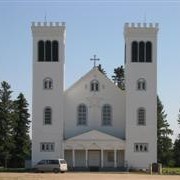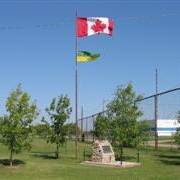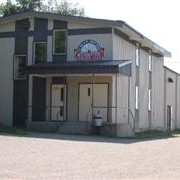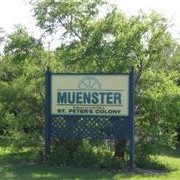History
The history of Muenster is somewhat unique on the prairies given that its growth was 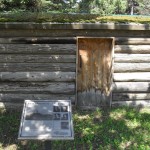 spurred to some extent by the development of a Benedictine monastery. The settlers of St. Peter’s Colony came largely from the American states. With the rapid opening of Saskatchewan to settlement during the 1890s, German settlers from the closest American states began to move north; in many instances they sent petitions to their former parishes for further immigrants to found new colonies. One such petition was received by a Benedictine priest in Minnesota, who then persuaded his superior, the abbot at St. John’s Abbey in Collegeville, Minnesota to establish a German Catholic colony in Saskatchewan. This abbey was in the heart of a large German Catholic colony. An exploration party was sent to Saskatchewan, headed by Rev. Bruno Doerfler and consisting of representatives from several parishes. Upon their return to Minnesota, the decision to establish the colony was made and the Volksverein German-American Land Company was founded. In 1902 this company, in conjunction with the priests of the Order of St. Benedict and the Catholic
spurred to some extent by the development of a Benedictine monastery. The settlers of St. Peter’s Colony came largely from the American states. With the rapid opening of Saskatchewan to settlement during the 1890s, German settlers from the closest American states began to move north; in many instances they sent petitions to their former parishes for further immigrants to found new colonies. One such petition was received by a Benedictine priest in Minnesota, who then persuaded his superior, the abbot at St. John’s Abbey in Collegeville, Minnesota to establish a German Catholic colony in Saskatchewan. This abbey was in the heart of a large German Catholic colony. An exploration party was sent to Saskatchewan, headed by Rev. Bruno Doerfler and consisting of representatives from several parishes. Upon their return to Minnesota, the decision to establish the colony was made and the Volksverein German-American Land Company was founded. In 1902 this company, in conjunction with the priests of the Order of St. Benedict and the Catholic 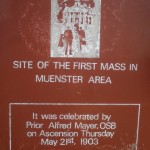 Settlement Society of St. Paul, Minnesota obtained colonization rights to a vast area in north-central Saskatchewan: fifty townships, covering 1,800 square miles. The German-American Land Company was responsible for buying 100,000 acres of railroad lands in the district selected and for selling it to settlers desiring more than the usual quarter-section homestead. The priests were to develop parishes and be primarily responsible for the expansion of the settlement. The Catholic Settlement Society extensively advertised the venture and assisted the settlers in filing for their homesteads. (“German Settlements”, The Encyclopedia of Saskatchewan.)
Settlement Society of St. Paul, Minnesota obtained colonization rights to a vast area in north-central Saskatchewan: fifty townships, covering 1,800 square miles. The German-American Land Company was responsible for buying 100,000 acres of railroad lands in the district selected and for selling it to settlers desiring more than the usual quarter-section homestead. The priests were to develop parishes and be primarily responsible for the expansion of the settlement. The Catholic Settlement Society extensively advertised the venture and assisted the settlers in filing for their homesteads. (“German Settlements”, The Encyclopedia of Saskatchewan.)
The village of Muenster, just walking distance to the north east of the current St. Peter’s Abbey, was incorporated in 1908. From its earliest pioneering beginnings, Muenster has evolved an adapted through the years to the modern community of today close to the amenities of cities, parks, lakes and recreation sites of central Saskatchewan.


